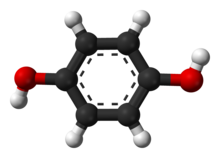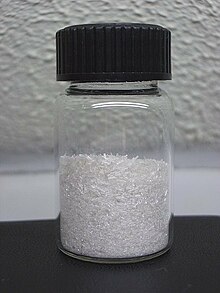
Back هيدروكينون Arabic Hidroxinon Azerbaijani هیدروکینون AZB Гідрахінон Byelorussian Hidroquinona Catalan Hydrochinon Czech Hydrochinon German Υδροκινόνη Greek Hidrokinono Esperanto Hidroquinona Spanish

| |

| |

| |
| Names | |
|---|---|
| Preferred IUPAC name
Benzene-1,4-diol[1] | |
| Other names | |
| Identifiers | |
3D model (JSmol)
|
|
| 605970 | |
| ChEBI | |
| ChEMBL | |
| ChemSpider | |
| DrugBank | |
| ECHA InfoCard | 100.004.199 |
| EC Number |
|
| 2742 | |
| KEGG | |
PubChem CID
|
|
| RTECS number |
|
| UNII | |
| UN number | 3077, 2662 |
CompTox Dashboard (EPA)
|
|
| |
| |
| Properties | |
| C6H6O2 | |
| Molar mass | 110.112 g·mol−1 |
| Appearance | White solid |
| Density | 1.3 g cm−3, solid |
| Melting point | 172 °C (342 °F; 445 K) |
| Boiling point | 287 °C (549 °F; 560 K) |
| 5.9 g/100 mL (15 °C) | |
| Vapor pressure | 10−5 mmHg (20 °C)[2] |
| Acidity (pKa) | 9.9[3] |
| −64.63×10−6 cm3/mol | |
| Structure | |
| 1.4±0.1 D[4] | |
| Pharmacology | |
| D11AX11 (WHO) | |
| Hazards | |
| GHS labelling: | |
   
| |
| Danger | |
| H302, H317, H318, H341, H351, H400 | |
| P201, P202, P261, P264, P270, P272, P273, P280, P281, P301+P312, P302+P352, P305+P351+P338, P308+P313, P310, P321, P330, P333+P313, P363, P391, P405, P501 | |
| NFPA 704 (fire diamond) | |
| Flash point | 165 °C (329 °F; 438 K) |
| Lethal dose or concentration (LD, LC): | |
LD50 (median dose)
|
490 mg/kg (mammal, oral) 245 mg/kg (mouse, oral) 200 mg/kg (rabbit, oral) 320 mg/kg (rat, oral) 550 mg/kg (guinea pig, oral) 200 mg/kg (dog, oral) 70 mg/kg (cat, oral)[5] |
| NIOSH (US health exposure limits): | |
PEL (Permissible)
|
TWA 2 mg/m3[2] |
REL (Recommended)
|
C 2 mg/m3 [15-minute][2] |
IDLH (Immediate danger)
|
50 mg/m3[2] |
| Related compounds | |
Related benzenediols
|
Pyrocatechol Resorcinol |
Related compounds
|
1,4-benzoquinone |
Except where otherwise noted, data are given for materials in their standard state (at 25 °C [77 °F], 100 kPa).
| |
Hydroquinone, also known as benzene-1,4-diol or quinol, is an aromatic organic compound that is a type of phenol, a derivative of benzene, having the chemical formula C6H4(OH)2. It has two hydroxyl groups bonded to a benzene ring in a para position. It is a white granular solid. Substituted derivatives of this parent compound are also referred to as hydroquinones. The name "hydroquinone" was coined by Friedrich Wöhler in 1843.[7]
In 2021, it was the 282nd most commonly prescribed medication in the United States, with more than 800,000 prescriptions.[8][9]
- ^ a b "Front Matter". Nomenclature of Organic Chemistry : IUPAC Recommendations and Preferred Names 2013 (Blue Book). Cambridge: The Royal Society of Chemistry. 2014. p. 691. doi:10.1039/9781849733069-FP001. ISBN 978-0-85404-182-4.
- ^ a b c d NIOSH Pocket Guide to Chemical Hazards. "#0338". National Institute for Occupational Safety and Health (NIOSH).
- ^ "Hydroquinone" (PDF). OECD SIDS. UNEP Publications. Archived from the original (PDF) on 20 October 2016. Retrieved 17 September 2018.
- ^ Lander, John J.; Svirbely, John J. Lander, W. J. (1945). "The Dipole Moments of Catechol, Resorcinol and Hydroquinone". Journal of the American Chemical Society. 67 (2): 322–324. doi:10.1021/ja01218a051.
{{cite journal}}: CS1 maint: multiple names: authors list (link) - ^ "Hydroquinone". Immediately Dangerous to Life or Health Concentrations (IDLH). National Institute for Occupational Safety and Health (NIOSH).
- ^ "Archived copy" (PDF). Archived (PDF) from the original on 2 February 2014. Retrieved 25 January 2014.
{{cite web}}: CS1 maint: archived copy as title (link) - ^ F. Wöhler (1844) "Untersuchungen über das Chinon" (Investigations of quinone), Annalen der Chemie und Pharmacie, 51 : 145-163. From page 146: "Das so erhaltene Destillat … enthält … einen neuen, krystallisierenden Körper, den ich unter dem Namen farbloses Hydrochinon weiter unten näher beschreiben werde." (The distillate so obtained … contains … a new, crystallizable substance, that I will describe, under the name of colorless hydroquinone, further below in more detail.) [Note: Wöhler's empirical formula for hydroquinone (p. 152) is incorrect because (1) he attributed 25 (instead of 24) carbon atoms to the molecule, and (2) as many chemists at the time did, he used the wrong atomic masses for carbon (6 instead of 12) and oxygen (8 instead of 16). With these corrections, his empirical formula becomes: C12H12O4. Dividing the subscripts by 2, the result is: C6H6O2, which is correct.]
- ^ "The Top 300 of 2021". ClinCalc. Archived from the original on 15 January 2024. Retrieved 14 January 2024.
- ^ "Hydroquinone - Drug Usage Statistics". ClinCalc. Retrieved 14 January 2024.
